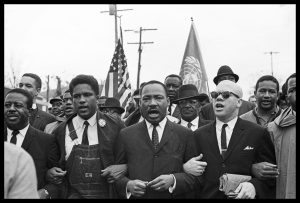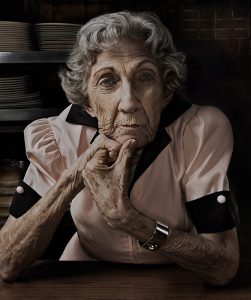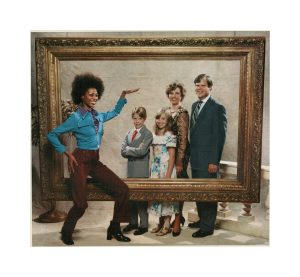
Five distinctive photographic voices are now on view at the Boca Raton Museum of Art in an exhibit called Myths, Secrets, Lies, and Truths: Photography from the Doug McCraw Collection.
The show, which opened last month and runs through Oct. 13, features the work of Sheila Pree Bright, Liesa Cole, Karen Graffeo, Spider Martin and Hank Willis Thomas. McCraw is the founder of the FATVillage Arts District in Fort Lauderdale, now under renovation with plans to reopen in 2027.
“‘Myths, Secrets, Lies and Truths’ presents five distinct voices that delve into and illuminate many aspects of life,” says Irvin Lippman, executive director of the Boca Raton Museum of Art, in a prepared statement.
“We are grateful to Doug McCraw for this collection of photography that stimulates conversation,” he says. “From historic milestones captured by Spider Martin, to Karen Graffeo’s striking, colorful images of the lives of people in Cuba and the Roma of Europe; from Hank Willis Thomas’ conceptual works on popular culture, to Leisa Cole’s dream-like scenes and Sheila Pree Bright’s topical portraits — all of these images resonate powerfully today.”
The exhibit was created by the museum’s senior curator, Kathleen Goncharov.
In addition to Thomas’s work, other images exploring themes of social justice include the photographs of Birmingham News photojournalist Spider Martin, who snapped thousands of images during the civil rights movement, including the historic 1965 Selma-to-Montgomery march.
Over the course of his assignment, Martin faced beatings and death threats from those opposed to desegregation and didn’t want his images promoting equal rights on the front page of the newspaper.
Three of his black-and-white images were reshot in high resolution and enlarged to 38-by-58 inches by Graffeo, who has worked with the Spider Martin Civil Rights Collection to restore his original black-and-white negatives to form the centerpiece of this exhibition.

Brothers in Arms depicts Martin Luther King Jr. and a group of Black men wearing “We Shall Overcome” buttons, the American flag flying behind them; The Prayer, featuring a group of Black men holding hands in prayer, a church steeple in the background; and Two Minute Warning, which captures the moment Alabama state troopers dressed in riot gear are poised to attack peaceful marchers with batons and tear gas after the marchers crossed the Edmund Pettus Bridge from Selma into Dallas County on March 7, 1965.
The incident was the catalyst for the passage of the 1965 Voting Rights Act, and became known as Bloody Sunday. King himself gave direct credit to Martin’s images for propelling the passage of the Voting Rights Act.
“Seeing these images enlarged is incredible,” says McCraw, an Alabama native who began collecting art 35 years ago, beginning with hand-sewn quilts by African-American artists from Alabama, such as Lonnie Holley, Thornton Dial and artists of the Gee’s Bend community, known for their unique patchwork style quilts.
“Anywhere I find talent, I have an interest in collecting,” McCraw says. “It’s an eclectic process.”

One of those collected artists is Graffeo, a choreographer, installation artist, photographer and professor emeritus of art at University of Montevallo in Alabama.
“It’s an honor to be a part of Doug’s art collection and to be shown at the Boca Raton Museum of Art,” she says. “It’s a good circle to be in.”
On display are five of her documentary photographs from her Cuba series, including Santero: Saint Maker, taken in Cuba in 2020 and depicting Afro-Cuban religious rites, LGBTQ images and quotidian images of life in Cuba, and Roma girl: no ticket, train of life and other portraits of Roma refugees in Europe.
Graffeo has visited various Roma communities for 15 years and says, “I found a warm and valuable humanity among the Roma.” In 2013, she received a Fulbright Senior Scholar Award to stay and photograph the Roma in Romania for a year.
In 2015, on her first visit to Cuba, Graffeo rented an apartment in central Havana and was welcomed with a gift of a live chicken, a cut-up pineapple, a glass of juice and a slice of birthday cake.
“I didn’t know what it was,” she remembers, “but I knew it was the story I wanted to learn.”
She learned it was part of a Santeria ritual and began documenting the rituals and practices.

In addition to the people, her Cuba series highlights the vibrant designs, colors, patterns and textures of the island.
“I am devoted to the mystery of what propels people to survive, to know each other and culture as a contemplation of shared horizons,” she says on her website. “Art is my spiritual transport and an elegant cultural mediator.”
A sixth piece on display is a 10-foot-tall installation titled Havana/Bama: Reconstructing a Shared Horizon, comprised of more than 300 items and miniature female images, “prizes” that came with Cuba’s tobacco products from the 1800s to the 1950s, collected from flea markets around the island.
Constructed as a vertical compass point, Graffeo added vials of water and pearls, acting, she notes, as a chandelier of memories. She says the piece was conceived as a tribute to the shared experience of the blue sky and water and history connecting both countries and people.
About her time in Cuba, Graffeo, who is still learning the language, says, “Cuban culture coalesced everything I could grow into as an artist and a photographer.”

Other photographs in the exhibit include Bright’s photographs from her Young Americans series, in which she invited millennials/Generation Y-ers to pose with the flag while recording their personal stories of what the flag means to them.
Thomas, a conceptual artist whose series, Unbranded: Reflections in Black by Corporate America, focuses on identity and pop culture, reconceptualized images from advertising campaigns aimed at a Black market between 1968 to 2008 to show how the ads exploited stereotypes and disrespected African-Americans.
Liesa Cole’s photographs, projections, and installations explore those who share secrets and those who keep them. Her show, Secret Keepers: The Secrets We Keep, The Stories We Tell, premiered at FATVillage in 2020.
A “fun, interactive exhibit,” according to McCraw, “Liesa’s work is powerful, brilliant, funny and sometimes dark.” So taken with it, McCraw purchased the whole series, including a secrets booth and video feed, This Is Life, both on display.
Her neon sculpture Truth, where the word “truth” is inscribed in reverse, reveals the whole truth, and nothing but the truth, only when the viewer sees their reflection in the mirror.
“Viewers will have a moving, powerful, engaging experience with these works,” says McCraw. “Some are funny, some serious, others more moving and inspirational.”
“Some will punch you in the gut,” he says. “It’s all of these things and more. No one can view all these images and not have a visceral experience. The work speaks for itself.”
Also at the museum and running through Oct. 20 is Sunshine, by Hudson, New York-based artist Julie Evans. Known for her paintings, watercolor and collages, Evans began making ceramics in 2019. This exhibition will feature her ceramics alongside her works on paper for the first time. The Boca Raton Museum of Art is located at 501 Plaza Real in Boca Raton. For hours and admission prices, visit bocamuseum.org.